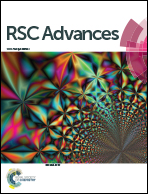Isolation, resolution and biological evaluation of pestalachlorides E and F containing both point and axial chirality†
Abstract
Marine life forms are an important source of structurally diverse and biologically active natural products. As a unique case of both enantiomeric and atropisomeric isomers being present in one marine natural product structure, two new dichlorinated diphenylmethanes containing both point and axial chirality, (±)-pestalachlorides E (1) and F (2), were isolated from a marine-derived Pestalotiopsis (ZJ-2009-7-6) fungus. Both of them showed potent antifouling activities against the larval settlement of the barnacle Balanus amphitrite at nontoxic concentrations with EC50 values of 1.65 and 0.55 μg mL−1, respectively, and antifouling activity was detected for the first time for this class of metabolites.


 Please wait while we load your content...
Please wait while we load your content...